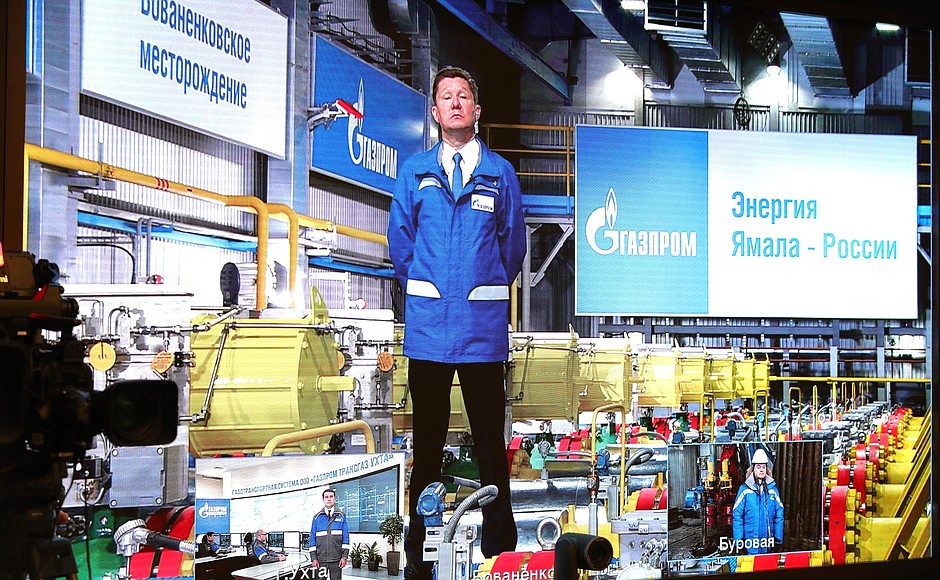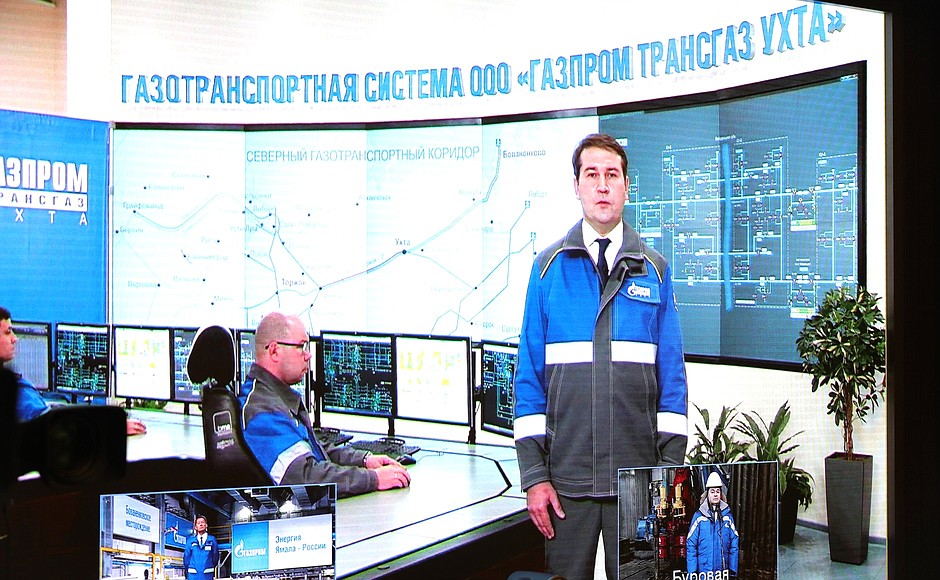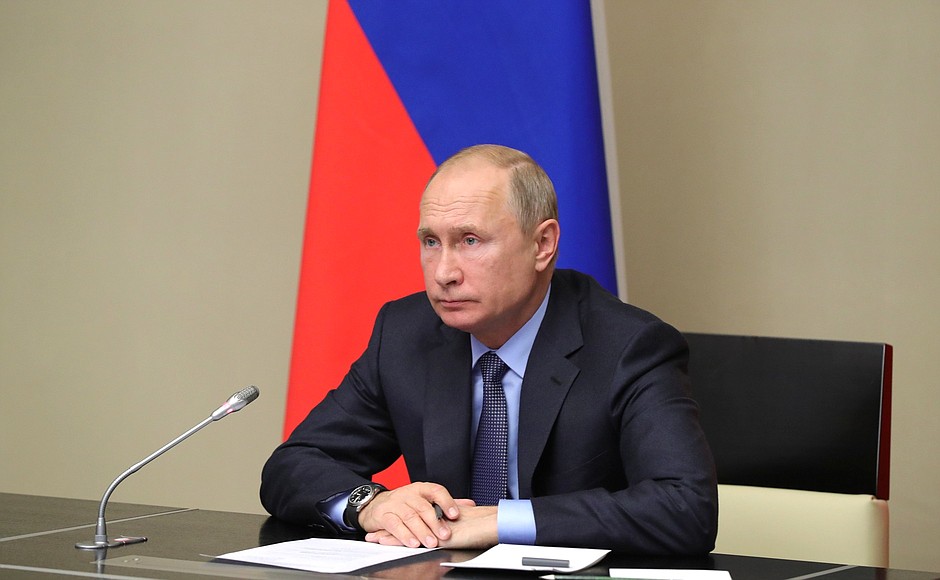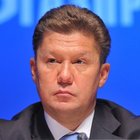President of Russia Vladimir Putin: Mr Miller, colleagues,
First of all, I would like to congratulate you on this major achievement: you have successfully completed a large-scale and complicated project.
Today, we are launching the third, and final, gas production facility of the unique Bovanenkovo oil and gas condensate field. This means that it will reach its full capacity.
At the same time we are opening the second line of the Ukhta-Torzhok gas pipeline. This will make it possible to deliver more gas from Yamal to central regions of the Russian Federation.
I would like to thank everyone involved in building these important industrial and infrastructure facilities.
This is a significant contribution to the development of Russia’s gas industry and the comprehensive exploration of Yamal. Engineers, geologists, gas workers and builders have created an enormous new modern Russian gas production centre, in the peninsula’s very challenging climatic conditions, almost from the ground up.
The work was really large-scale. Well-equipped production sites and camps for rotating workers were built along with the 572 km Obskaya – Bovanenkovo railway.
Each of these is a large and significant construction project in its own right. Many kilometres of pipelines and other facilities, including an airport, have been built; all of this in compliance with the strictest environmental requirements to preserve the tundra and vulnerable nature of Yamal.
The third production facility will increase Bovanenkovo capacity to the target level, or 115 billion cubic metres of gas per year. This number is colossal, without exaggeration. It equals a quarter of Gazprom’s current annual production. Mr Miller and I discussed this in the morning. This is almost half of what Gazprom provides for Russia’s domestic market and almost half of our exports, both to neighbouring and more distant countries. The scale is impressive.
Let me stress once again that such megaprojects as Bovanenkovo are very important for the national economy and the regions. They create jobs and improve the quality of life.
We are talking about gas production on Yamal. Let me remind you that the volume of Yamal’s largest gas field, Bovanenkovo, which we are taking to full capacity today, is 4.9 trillion cubic metres of gas. However, the exploration of Yamal does not end in Bovanenkovo. The explored gas supply in the peninsula is more than 16.7 trillion cubic metres. This is immense. It is expected that 310–360 billion cubic metres of gas will be produced here by 2030.

But this is not the end. We are developing the province in general and moving forward. This July we decided that the exploration of the Kharasavey gas field located north from Bovanenkovo will begin in full in early 2019. The work will begin in the near future, and production is scheduled to commence in 2023. The target level is 32 billion cubic metres of gas. At the same time, geological exploration continues at the Tambei group of fields. All of this means that our energy and gas sectors are developing at a good pace.
The growth in gas production will further strengthen the energy security of Russia and our export potential and fully cover such new routes as Nord Stream 2, which is already under construction. And, of course, there will be additional capacities to speed up the provision of gas supply to Russian cities and villages. Soon we will begin the preparations and will hold a separate meeting on expanding gas supply in Russia at the beginning of next year.
I would like to thank you all very much for your labour, hard work and results, for fulfilling the most complicated technological and industrial tasks. I am sure that your unique experience of work in the northern conditions will be in high demand in the future, including in new projects.
I express my gratitude to you once again. Thank you for the work you have done and the results you have achieved. I wish you success.
Mr Miller, please.
Gazprom CEO Alexei Miller: Mr President,
We are at the gathering station of the third gas production facility of the Bovanenkovo gas field, where all gas manifolds from all the production wells meet. The station’s task is to equalise the pressure of the streams and unite them in a single one.
Further in the process, the gas goes to the inlet separator station where the mechanical impurities and water are separated from the gas stream. The next stage is the low-temperature separation station where the gas is cooled down to minus 35 degrees, and the rest of water is separated from it. Then the dry gas goes to the booster pumping station where the pressure is raised to the working pressure of the main pipelines: 120 atmospheres.
There are 173 wells at the third gas production facility. We have with us the director general of Gazprom Dobycha Nadym who will report on production activity.
Vladimir Putin: Mr Menshikov, please.
Director General of Gazprom Dobycha Nadym Sergei Menshikov: Mr President, Mr Miller,
I am Sergei Menshikov, Director General of Gazprom Dobycha Nadym.
We are currently here, at the Yekaterina drilling rig. This Russian-produced fourth-generation drilling rig allows us to work in the harsh Arctic environment and drill wells with complex configurations from various angles. This particular well, for instance, will be 1,700 metres deep, and will be drilled at a distance of 790 metres from the rig.

The drilling bit enters the well with the help of drill pipes. Each pipe is eight metres long. You can now see the drillers use the top drive to bring the so-called stand consisting of three 24 metre-long drill pipes to the wellhead. Then, the threaded connection is cleaned, and a special thread lubricant is applied.
Now, we make up connections with the help of hydraulic drilling power tongs. While spinning the drilling bit, the turbodrill lowers the drill pipe stand into the well by 24 metres. The entire process is controlled by a joystick, operated by the driller working in the rig’s control cabin. The drilling fluid used for flushing the well is pumped through the pipes. The rock that is extracted from the well together with the drilling fluid is decontaminated with the help of a special installation, and then used as an environmentally friendly construction material for road and site filling.
That concludes my report.
Vladimir Putin: Thank you.
Alexei Miller: Mr President.
The Bovanenkovo gas field reserves are so large that production will continue up to 2128, that is, for the next 110 years.
Bovanenkovo has an airport that can service almost all classes of aircraft used in the Russian Federation. It also has the 572-kilometre Salekhard-Bovanenkovo railway. The living conditions of local employees are as comfortable as possible. All the necessary transport and social infrastructure has been created here.
The Yamal Peninsula development will continue rapidly. As you mentioned, this July, a decision was taken to begin the full-scale development of the Kharasavey field starting January 1, 2019. This field has estimated reserves of 2 trillion cubic metres. At the same time, we are now exploring the Tambei group of fields.
New gas production capacities are being created at the same time with gas transmission capacities. New gas transmission capacities have been created in the northern corridor to transmit 115 billion cubic metres of gas from Bovanenkovo and today we are putting into operation the Ukhta-Torzhok 2 main gas pipeline. The northern gas transmission corridor is becoming crucial for the country’s unified gas supply system, both for supplying the domestic market and for export.
Now we will go to Director General of Gazprom Transgaz Ukhta.
Vladimir Putin: Please, Mr Gaivoronsky.
Director General of Gazprom Transgaz Ukhta Alexander Gaivoronsky: Mr President, Mr Miller,
This is Director General of Gazprom Transgaz Ukhta Alexander Gaivoronsky.

We are at the production control department operating main gas pipelines in the northern corridor.
The primary function of the northern corridor is sending gas from the Bovanenkovo field to consumers in Russia and abroad. Our company operates over 16,000 km of pipeline, including Bovanenkovo-Ukhta (first and second lines), Ukhta-Torzhok and Ukhta-Torzhok 2, the 970 km pipeline we are putting into operation today.
Mr President, Mr Miller,
I can now report that the Ukhta-Torzhok 2 pipeline infrastructure is connected to Russia’s unified gas supply system and gas is flowing in the target volumes.
That concludes my report.
Alexei Miller: Mr President,
Exactly 10 years ago, in December 2008, it was decided to create a new gas production centre in Russia on the Yamal Peninsula. Today we have brought a major field of this new gas extraction centre to the target capacity of 115 billion cubic metres of gas a year.
That concludes my report.
Vladimir Putin: Thank you.
I will repeat this number: 16.7 trillion cubic metres of gas on Yamal alone. These are vast reserves that are global in scale and will allow Russia to move confidently in the direction of consolidating its power security, and to guarantee reliable deliveries to our foreign partners.
Once again, congratulations on this result which is important for the whole economy of Russia.
I wish you new successes and achievements.
Thank you.

